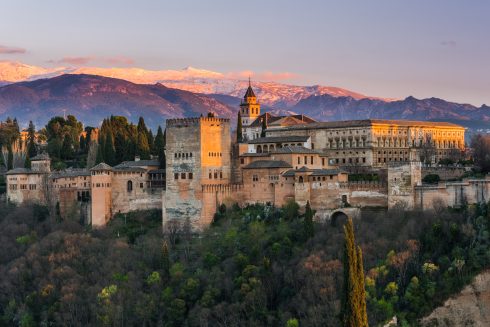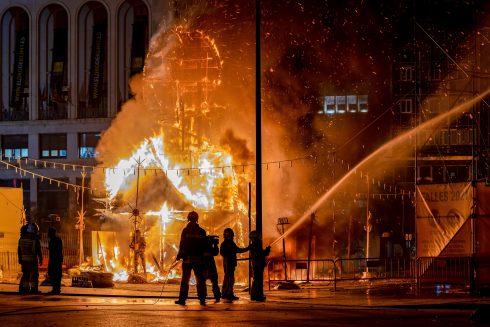FROM the moment you step onto the Toledo train from Madrid, El Greco’s legacy in Castilla La Mancha is clear.
The renaissance artist’s works are splashed across the backs of seats and his name is inscribed on every building passed en route to the historic town.
Once in Toledo, around every corner iconic heavy-lidded eyes loom down at you from super-sized El Greco paintings, luring you into one of the many exhibition venues.
From convents to restaurants to art galleries – perhaps the last is less surprising – everywhere in this imperial town honours the 400 year anniversary of the death of art’s greatest nickname.
The Greek – less catchily known as Domenikos Theotokopoulos – retains a powerful influence both in this town and the international art world.
A man of expensive tastes but limited finances, by the time of his death on April 7 1614 many of El Greco’s works were scattered throughout the city as compensation for unpaid bills.
This is how they remain, littered like hidden insights into his life, in Toledo’s many nooks and crannies.
Clues as to the resting places of his paintings come in the form of giant pink dots, daubed on the outside of buildings which play host to the works.
Each of the many venues in the El Greco trail captures a different side of this multi-dimensional character: the artist, the man, the outsider, the architect and the lighting designer, to name a few.
The artist
The Museo de Santa Cruz is currently home to the largest exhibition of El Greco’s works ever held – more than a hundred have been gathered from 29 different cities worldwide.
The exhibition maps the controversy that followed him throughout his career which, combined with his reputation for arrogance and disproportionate fees, made him an unpopular and heavily criticised artist.
But the spectator is drawn to El Greco’s art.
Through intense colours and dramatic chiaroscuro effects, El Greco creates something more beautiful, more stylised and dynamic than reality, in a determined exploitation of artistic licence.
The man
He comes to life in the Casa-Museo del Greco – an incredible reconstruction of a 14th century house in the town’s old Jewish quarter.
Under the false impression he was buying the painter’s actual home, the Marquis de la Vega Inclan snatched up the house in the early 20th century to create a ground-breaking exhibition space.
He has restored the house and recreated the atmosphere of the different rooms with spectacular attention to detail, evoking the artist’s private life and personality.
As well as offering a glimpse into how El Greco himself would have lived, the museum reveals fascinating detail into the daily running of his workshop.
From this workshop, El Greco designed and created sculptures, altarpieces for monasteries and convents, intricate architecture and ingenious lighting designs, with the help of his numerous assistants.
The outsider
Although by the end of his career El Greco was hailed as a reflector of the true Castilian soul, he was always a foreigner in Toledo.
Living in the town for ten years without residency, he is still simply known as ‘The Greek’ – his nickname highlighting his inability to belong.
It is this aspect of El Greco that the Sephardic Museum chooses to represent, alongside an immense six metre by three metre work of art entitled ‘Shoah’ by the late German artist Wolf Vostell.
The ‘misunderstanding’ of the work of both artists has inspired the museum to take part in the 400th anniversary events from a different perspective, of notions of ‘them’ and ‘us’ against a background of global multiculturalism and tolerance.
Legacy
His original painting style, his unique use of colour, and – by the end of his career – his ability to reflect the true Castilian soul sparked El Greco’s success in Toledo.
But he was a chameleon. Throughout his training he travelled from Crete to Venice to Rome, always perfecting the fashionable artistic techniques and capturing the spirit of the cities he temporarily called home.
In Crete he picked up his conceptual style, learning to create impossible landscapes to represent invisible worlds.
From there he moved to Venice, and in just three years mastered the use of oil paints to an astonishing degree. From Titian and Tintoretto – two influential Venetian painters – he learnt to create, mix and blend colours, contrasting and illuminating them to achieve maximum visual impact.
In Rome he developed his skill for portraits and religious works. It was through his contact with the Mannerist style – a legacy of Michelangelo – that El Greco’s most renowned characteristic was born, the infamous elongated human form.
But despite his talent for absorbing and reflecting the character of his surroundings, it was in Toledo that El Greco chose to make his home, starting a family there and remaining there until he died.
He was born a Greek, trained as an Italian, but lived and died a Castilian – the most sincere character of the most traditional Spain.







